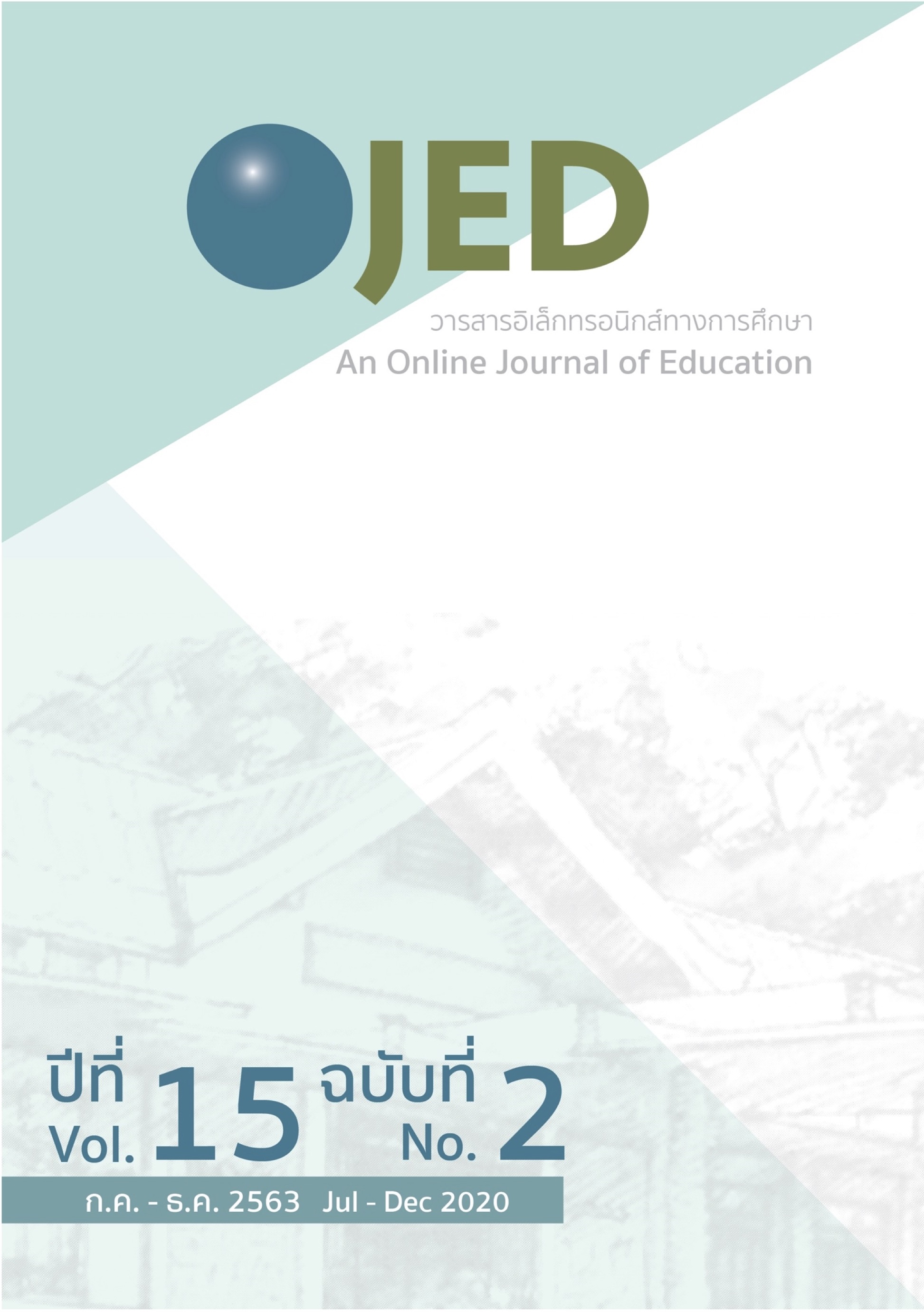Effects of Science Project Instruction using Engineering Design Process on Creative Problem Solving Abilities of Lower Secondary School Students under the Office of the Higher Education Commission
DOI:
https://doi.org/10.14456/ojed.2020.43Keywords:
engineering design process, creative problem solving abilitiesAbstract
The purposes of this research were 1) to compare the creative problem solving abilities of lower secondary school students before, between and after learning science project by using engineering design process and 2) to study the creative problem solving abilities of lower secondary school after learning science project by using engineering design process. The research sample was included 46 eighth grade students of demonstration schools of university under the office of the higher education commission selected by using purposive sampling. The instruments used in the experiment were the science project lesson plans using engineering design process. The research instrument for data collection were the creative problem solving abilities test with reliability at .817. The data were analyzed by arithmetic mean, standard deviation and repeated measure ANOVA. The results of this research were found that the creative problem solving abilities after learning science project by using engineering design process were higher than those of students before learning and between learning at a .05 level of significance and the creative problem solving abilities after learning science project by using engineering design process were high in all translation composition.
References
กฤษลดา ชูสินคุณาวุฒิ. (2557). กระบวนการออกแบบเชิงวิศวกรรมคืออะไร. วารสารสถาบันส่งเสริมการสอนวิทยาศาสตร์และเทคโนโลยี, 42(190), 37-40.
พรสวรรค์ วงค์ตาธรรม. (2558). การคิดแก้ปัญหาเชิงสร้างสรรค์ ทักษะการคิดในศตวรรษที่ 21. วารสารศึกษาศาสตร์ มหาวิทยาลัยขอนแก่น, 38(2), 111-121.
มนูญ ตนะวัฒนา. (2539). ศิลปะการเสริมสร้างพลัง ความคิดสร้างสรรค์ (พิมพ์ครั้งที่ 3). ธีรพงษ์การพิมพ์. สถาบันวิจัยพฤติกรรมศาสตร์. (2558). คู่มือครู การจัดการเรียนรู้แบบแก้ปัญหาอย่างสร้างสรรค์. https://candmbsri.files.wordpress.com/2015/05/crative-problem-solving.pdf.
สำนักงานคณะกรรมการนโยบายวิทยาศาสตร์ เทคโนโลยี และนวัตกรรมแห่งชาติ. (2562). สถานการณ์และแนวโน้มวิทยาศาสตร์ เทคโนโลยี และนวัตกรรมของประเทศไทย. http://stiic.sti.or.th/sti-thailand/
สำนักงานเลขาธิการสภาการศึกษา กระทรวงศึกษาธิการ. (2560). แผนการศึกษาชาติ พ.ศ. 2560-2579. พริกหวานกราฟฟิค.
สุกัญญา เชื้อหลุบโพธิ์. (2560). การจัดการเรียนรู้โดยใช้กระบวนการออกแบบเชิงวิศวกรรมตามแนวคิดสะเต็มศึกษา เพื่อพัฒนาความคิดสร้างสรรค์ เรื่อง การเคลื่อนที่แบบหมุน ของนักเรียนชั้นมัธยมศึกษาปีที่ 4. วารสารวิชาการและวิจัยสังคมศาสตร์ มหาวิทยาลัยนเรศวร, 13(37), 119-132.
สุกัลยา ขำเพชร. (2543). การศึกษาสภาพและปัญหาในการทำโครงงานวิทยาศาสตร์ของนักเรียนมัธยมศึกษาตอนต้น จังหวัดเพชรบุรี [วิทยานิพนธ์ปริญญามหาบัณฑิต ไม่ได้ตีพิมพ์]. สถาบันเทคโนโลยีพระจอมเกล้าเจ้าคุณทหารลาดกระบัง.
สุธิดา การีมี. (2560). การใช้กระบวนการออกแบบเชิงวิศวกรรมเพื่อเสริมสร้างความคิดสร้างสรรค์และทักษะการแก้ปัญหา. วารสารสถาบันส่งเสริมการสอนวิทยาศาสตร์และเทคโนโลยี, 46(209), 23-27.
อภิสิทธิ์ ธงไชย. (2559). ความสำคัญของวิศวกรรมในการจัดการเรียนรู้วิทยาศาสตร์ในศตวรรษที่ 21. วารสารศึกษาศาสตร์ปริทัศน์. 31(3), 48-53.
Creative Education Foundation. (2014). Educating for Creativity Level 1 Resource Guide. http://www.creativeeducationfoundation.org/wp-content/uploads/2015/06/EFC-Level-1-FINALelectronic.pdf
Mangold, J., & Robinson, S. (2013, June). The engineering design process as a problem solving and learning tool in K-12 classrooms [Paper Presentation]. 120th ASEE Annual Conference & Exhibition, Atlanta, USA.
Organisation for Economic Co-Operation and Development (OECD). (2016), Global competency for an inclusive world. https://www.oecd.org/education/Global-competency-for-an-inclusive-world.pdf.
Science Buddies. (2019). Engineering design project guide. https://www.sciencebuddies.org/science-fair-projects/engineering-design-process-guide.
TeachEngineering. (2018). Engineering design process. https://www.teachengineering.org/k12engineering/why.
Treffinger, D. J. (2007). Creative problem solving (CPS): Powerful tools for managing change and developing talent. Gifted and Talented International, 22(2), 8-18.
Treffinger, D. J., Isaksen, S. G., & Stead-Dorval, K. B. (2010). Creative problem solving (CPS Version 6.1™) A Contemporary Framework for Managing Change. http://www.creativelearning.com/~clearning/images/freePDFs/CPSVersion61.pdf.
Downloads
Published
How to Cite
Issue
Section
License
Copyright (c) 2020 An Online Journal of Education

This work is licensed under a Creative Commons Attribution-NonCommercial-NoDerivatives 4.0 International License.




